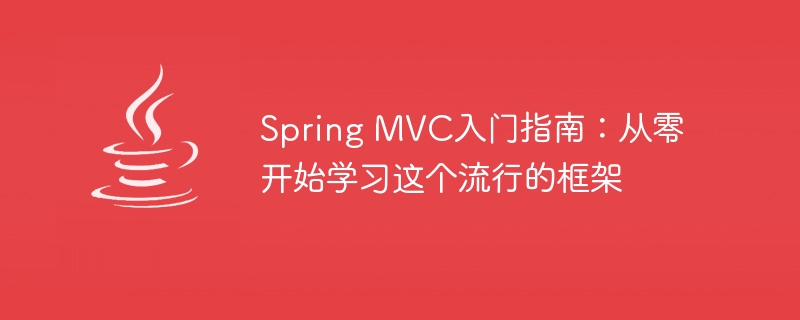

Spring MVC Getting Started Guide: Learn this popular framework from scratch, specific code examples are required
Introduction:
With the rapid development of the Internet and Web applications With the increasing popularity of web applications, building efficient and scalable web applications has become a focus of developers. The Spring MVC framework, as one of the most popular web application frameworks in Java development, has the advantages of flexibility, modularity and testability, and is widely used in many projects. This article will provide you with an introductory guide to Spring MVC, learn this popular framework from scratch, and provide specific code examples.
2.1 Create a project:
In the IDE, select New Project, select the Spring MVC project template, and fill in relevant information, such as project name and package name.
2.2 Configure web.xml:
Find the web.xml file in the project's WebContent/WEB-INF directory, and configure the core controller of Spring MVC - DispatcherServlet. Add the following code in web.xml:
<servlet>
<servlet-name>dispatcher</servlet-name>
<servlet-class>org.springframework.web.servlet.DispatcherServlet</servlet-class>
<init-param>
<param-name>contextConfigLocation</param-name>
<param-value>/WEB-INF/spring-mvc.xml</param-value>
</init-param>
<load-on-startup>1</load-on-startup>
</servlet>
<servlet-mapping>
<servlet-name>dispatcher</servlet-name>
<url-pattern>/</url-pattern>
</servlet-mapping>In the above configuration, we specified the location of the DispatcherServlet configuration file spring-mvc.xml, and mapped the DispatcherServlet to the root path "/".
3.1 Create the Controller class:
Create a Java class named HelloController in the src directory, and add the @Controller annotation and @RequestMapping annotation, as shown below:
@Controller
@RequestMapping("/hello")
public class HelloController {
@RequestMapping("/greeting")
public String greeting(Model model) {
model.addAttribute("message", "Hello, Spring MVC!");
return "greeting";
}
}In the above code, we use the @Controller annotation to mark this class as a Controller, and use the @RequestMapping annotation to specify the Controller's request path as "/hello". In the greeting method, we pass a message to the view named "greeting" through the Model object.
3.2 Create a view:
Create a JSP page named greeting.jsp in the WEB-INF directory to display messages passed by the Controller. In greeting.jsp, we can use the JSTL tag library and EL expressions to display messages, as shown below:
<!DOCTYPE html>
<html>
<head>
<title>Greeting</title>
</head>
<body>
<h1>${message}</h1>
</body>
</html>In the above code, we use the EL expression ${message} to obtain the Controller delivery message and display it on the page.
4.1 Compile and build the project:
In the IDE, select the project, right-click to select the Build or Rebuild option, compile the source code of the project, and generate the corresponding build output according to the project configuration information.
4.2 Deploy the project:
Deploy the compiled project to a web server, such as Tomcat or Jetty.
4.3 Run the project:
After the Web server is started, enter "http://localhost:8080/
Conclusion:
This article provides you with a guide to getting started with Spring MVC by creating a simple Spring MVC project and providing specific code examples. I hope this article can help you learn this popular framework from scratch and provide a reference for your future web application development work. Through continuous practice and in-depth learning, you will be able to use Spring MVC more proficiently and improve your development efficiency and web application performance through its powerful functions. I wish you success in your journey of learning Spring MVC!
The above is the detailed content of Learn the basics of Spring MVC: Master this popular framework from scratch. For more information, please follow other related articles on the PHP Chinese website!